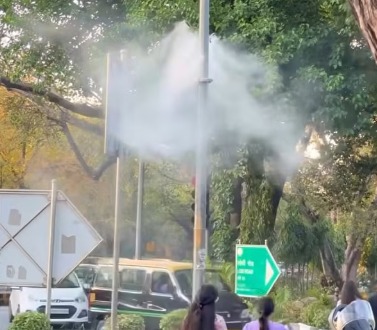To promote environmental sustainability, continuous efforts are being made to keep the NDMC area clean, green, and pollution-free. As part of this mission, NDMC Vice Chairman Kuljeet Singh Chahal announced that in Phase II, the “Mist Sprayer” Project is now being installed on electric poles in prominent areas like Africa Avenue and Shantipath. This is an important step toward effectively controlling air pollution and providing citizens with a cleaner environment.

Chahal explained that mist sprayers mounted on electric poles are a modern and effective method of air pollution control. These sprayers release fine water droplets that help settle dust and pollutants in the air, thereby improving air quality and offering a cleaner environment for breathing. Their effectiveness is especially significant in densely populated and high-traffic areas. This system not only helps reduce pollution but also supports greenery maintenance. Moreover, when treated water is used, it contributes to water conservation efforts.

He further mentioned that the first phase of this project was successfully implemented on Lodhi Road, where 15 mist sprayers were installed on a 500-meter stretch of road. This initiative cost approximately ₹34 lakh and received positive feedback from various sector. Building on this success, the technology is now being deployed in the second phase on key roads like Shantipath and Africa Avenue. The NDMC aims to gradually expand this innovation across the entire NDMC area.
On Africa Avenue, mist sprayers will be installed on 30 electric poles along an approximately 850-meter stretch. Each pole will be equipped with five nozzles, each containing six spray holes—resulting in water being sprayed from 30 points per pole. The system will use about 84 liters of treated water per hour per pole. For this, four tanks with a capacity of 5,000 liters each will be installed. A similar system will be implemented on a roughly 900-meter section of Shantipath. Work orders have already been issued, and the project is expected to be completed within one month during July-August 2025.
NDMC has already implemented several advanced pollution control measures. Mechanical Road Sweepers (MRS) equipped with GPS tracking are deployed for road cleaning and are monitored through the Smart City Integrated Command and Control Center. Anti-smog guns and mist spray machines procured by the Council are regularly used to control dust and particulate matter in the air. Additionally, treated water is sprayed on roadside trees, plants, and shrubs using 5,000 to 10,000-liter capacity tankers to avoid wastage of fresh water.
To promote greenery, NDMC regularly conducts tree plantation drives. Maintenance of green belts along roadsides, regular watering, and effective dust control measures at construction sites are also being enforced.
Chahal stated that Team NDMC is inspired by the vision of Hon’ble Prime Minister Narendra Modi for “Viksit Bharat@2047” and the “Ease of Living” mission. The team is committed to ensuring the highest standards of environmental sustainability, implementing effective pollution control measures, and continuously improving the quality of life for citizens.


